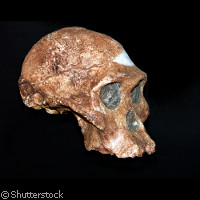Draft version of the Neanderthal genome completed
German and American scientists presented a complete draft version of the Neanderthal genome at the 2009 Annual Meeting of the American Association for the Advancement of Science (AAAS) in Chicago, US, on 12 February. The researchers believe the information will help to clarify the relationship between humans and Neanderthals, and shed light on the genetic factors that made possible the rapid migration of humans from Africa, around 90,000 years ago. Neanderthals cohabited with modern humans in Europe and parts of Asia for thousands of years before they died out around 29,000 years ago. Because DNA fragments can survive for millennia, scientists have been able to study the DNA from Neanderthal fossils since 1997. By comparing parts of the Neanderthal genome with that of modern humans, they have found surprising similarities between the two, and have believed that modern humans and Neanderthals might share a common ancestor. In the current study, a team led by Professor Svante Pääbo of the Max Planck Society, who first sequenced Neanderthal mitochondrial DNA in 1997, used new methods to sequence more than one billion DNA fragments from three Neanderthal fossils found in Croatia. With the help of a commercial company, the researchers managed to sequence more than 3 billion fragments of Neanderthal DNA, which represent more than 60% of the entire Neanderthal genome. The technology was first used in 2006 to study Neanderthal DNA. Since then, the technique has been refined. The group produced 'sequencing libraries' under clean-room conditions, to prevent the experiments from being contaminated by the staff's human DNA. In addition, they designed 'DNA sequence tags', unique identifiers that are attached to the ancient DNA molecules so as to ensure the samples aren't contaminated by other sources of DNA. Radioactively labelled DNA was also used to locate where material is lost during the sequencing procedure, making the process more efficient. Because of the efficiency of the improved sequencing technique, the need for material was dramatically reduced. Altogether, less than half a gram of precious fossilised bone was used. The greatest part of the sequence was established using samples of Neanderthal bones from Vindija Cave in Croatia. Several million Neanderthal base pairs from other sites were also studied, including bones from El Sidron, Spain and from the Mezmaiskaya Cave in the Caucasus. A sample from a 40,000-year-old Neanderthal-type specimen found in 1856 in the Neander Valley in Germany was also examined; this specimen has been used to define the Neanderthals as a group. The scientists examined errors in the ancient DNA sequences, and identified those that could be attributed to time-related changes that occur in fossilised remains. They then identified which of the fossil DNA fragments belonged to the Neanderthal, and which belonged to microorganisms that had colonised the bones over the years. Once this was established, a novel and highly sensitive computer algorithm was used to order the Neanderthal DNA fragments so that they could be compared with the human genome. Preliminary results suggest that Neanderthals have contributed only a small fraction of the variation found in contemporary human populations. An international consortium of researchers plans to investigate many genes of special interest in recent human evolution, including FOXP2, which is involved in speech and language in modern humans. Genes that are implicated in brain ageing and development will also be examined, as it has been suggested that variants of these found in modern humans may have come from Neanderthals. A full comparison of this 'first draft' of the Neanderthal genome with the previously sequenced human and chimpanzee genomes will, it is hoped, shed light on why humans were able to successfully migrate while their neighbours died out.
Countries
Germany, United States



